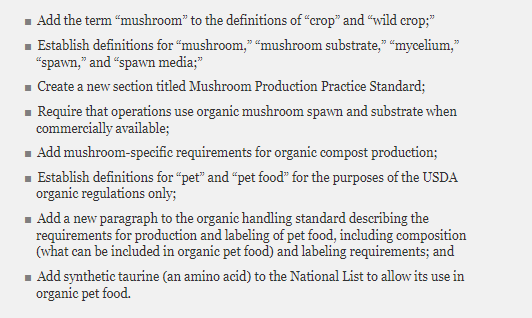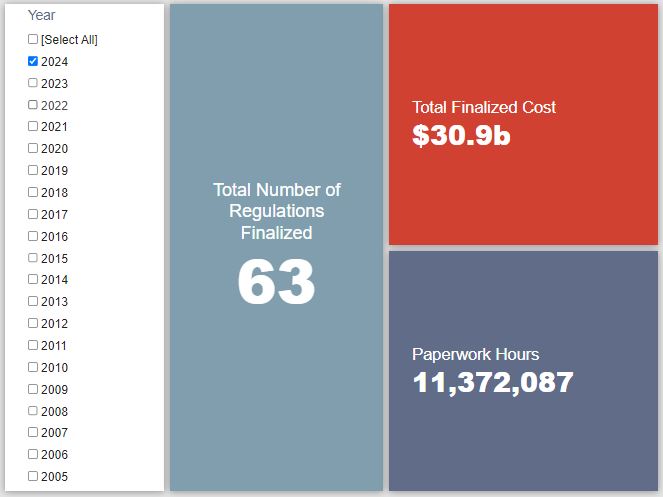Week in Regulation
March 18, 2024
Energy and Environment Rules Dominate the Week
The second week of March saw a continued, steady flow of regulatory actions. There were 14 rulemakings that had some quantifiable economic impacts. The main items of the week included a pair of energy efficiency rules from the Department of Energy (DOE) and an Environmental Protection Agency (EPA) measure on how various facilities store and manage hazardous chemicals. Across all rulemakings, agencies published $8.2 billion in total costs and added 572,379 annual paperwork burden hours.
REGULATORY TOPLINES
- Proposed Rules: 35
- Final Rules: 73
- 2024 Total Pages: 19,195
- 2024 Final Rule Costs: $30.9 billion
- 2024 Proposed Rule Costs: $31.5 billion
NOTABLE REGULATORY ACTIONS
The most active agency of the week was DOE with two sets of energy efficiency standards. Turns out there was laundry theme to this pair of rules. The more significant of the two established new standards for residential clothes washers while the other focused on consumer clothes dryers. The former brings roughly $5.4 billion in total costs while the latter would involve $600 million in total costs.
Interestingly, much like another set of efficiency standards for refrigerators published in January, these two rules come in the form of “direct final rules” based upon an apparent agreement among relevant stakeholders to effectively skip the usual proposed rule step. Typically, direct final rules are more vulnerable to being withdrawn based on adverse comments – and thus each of these had a concurrently published proposed version as a sort of backstop. This emerging pattern from DOE, however, suggests that the agency increasingly considers this to be a viable path for updating these standards. It is a trend worth monitoring.
The other main action of the week was the EPA rule regarding “Accidental Release Prevention Requirements: Risk Management Programs Under the Clean Air Act; Safer Communities by Chemical Accident Prevention.” The rule seeks to “improve chemical process safety; assist in planning, preparedness, and response to Risk Management Program-reportable accidents; and improve public awareness of chemical hazards at regulated sources.” EPA expects it to affect nearly 12,000 facilities across the country varying from petroleum refineries to food manufacturers to wastewater plants. The agency estimates the rule’s new standards will involve roughly $1.8 billion in total costs over a 10-year window, or $297 million on an annualized basis.
TRACKING THE ADMINISTRATIONS
As we have already seen from executive orders and memos, the Biden Administration will surely provide plenty of contrasts with the Trump Administration on the regulatory front. And while there is a general expectation that the current administration will seek to broadly restore Obama-esque regulatory actions, there will also be areas where it charts its own course. Since the AAF RegRodeo data extend back to 2005, it is possible to provide weekly updates on how the top-level trends of President Biden’s regulatory record track with those of his two most recent predecessors. The following table provides the cumulative totals of final rules containing some quantified economic impact from each administration through this point in their respective terms.![]() The final rules discussed above accounted for most of the movement in the Biden Administration’s to-date regulatory tally. For the other administrations, however, there was not much to report on. There was virtually no movement in the Obama-era totals. The Trump Administration saw a net cost increase of roughly $216 million. That total was primarily a result of $553 million in new costs from a Department of Labor rule on apprenticeships clashing with $344 million in cost reductions from a deregulatory EPA measure.
The final rules discussed above accounted for most of the movement in the Biden Administration’s to-date regulatory tally. For the other administrations, however, there was not much to report on. There was virtually no movement in the Obama-era totals. The Trump Administration saw a net cost increase of roughly $216 million. That total was primarily a result of $553 million in new costs from a Department of Labor rule on apprenticeships clashing with $344 million in cost reductions from a deregulatory EPA measure.
THIS WEEK’S REGULATORY PICTURE
This week, the Department of Agriculture (USDA) seeks to clarify the regulatory standards surrounding organic mushrooms and organic pet food. Source: Photo by gary tuck on Unsplash
Source: Photo by gary tuck on Unsplash
Last Monday, USDA published a proposed rule entitled “National Organic Program; Market Development for Mushrooms and Pet Food.” At first glance, one may be confused at the connection between mushrooms and pet food, two categories of items that are not typically associated with each other. Rest assured, the proposal does not necessarily focus on the nexus between the two but rather seeks to establish the criteria for them to be “organic” since, apparently, “Specific standards for these products do not currently exist.”
The main reason these product categories are in organic food “limbo” is that they sit outside the assumed parameters of broader, adjacent food categories. For mushrooms, one may consider them a “crop” of sorts given how they’re harvested and how you generally find them in the produce aisle among the fruits and vegetables. Most of the standards for organic “crops,” however, center upon plant growth characteristics. As fungi, such characteristics do not technically apply to mushrooms.
Somewhat similarly on the pet food side, while there are established standards for organic livestock feed to one might try to draw from, it is not necessarily congruous since livestock feed is generally plant-based. Since, for dietary reasons, most pet food – especially that for dogs and cats – involves animal-based ingredients (called “slaughter by-products” in this proposal), it is not as simple as merely applying the livestock feed standards to these products.
As such, this proposal seeks to make the following changes to relevant regulatory code:
USDA seeks further public input on nine topic areas here. Interested parties have until May 10, 2024, to submit comments on the matter.
Interested parties have until May 10, 2024, to submit comments on the matter.
TOTAL BURDENS
Since January 1, the federal government has published $62.4 billion in total net costs (with $30.9 billion in new costs from finalized rules) and 29.4 million hours of net annual paperwork burden increases (with 11.4 million hours coming from final rules). 










